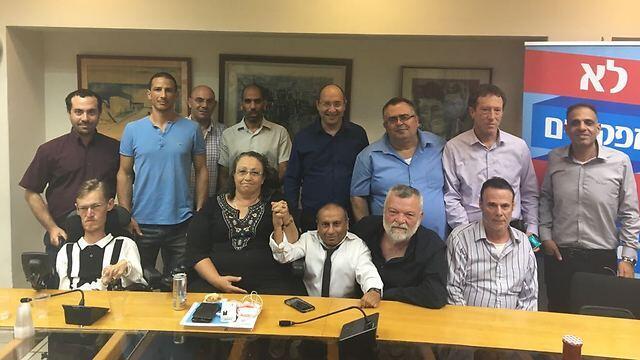Getting your Trinity Audio player ready...
At the end of a months-long struggle ,an agreement was signed Friday between the disability organizations and government representatives to raise disability pensions.
The agreement was reached after 12 hours of arduous negotiations held at the offices of Israel's national trade union center, the Histadrut.
The meeting was attended by the six heads of organizations chosen to represent the handicapped, Histadrut chairman Avi Nissenkorn ,coalition chairman MK David Bitan (Likud), Ilan Gilon (Meretz) and Prof. Avi Simhon, a government representative who endorsed the recommendations of Dr. Yaron Zelekha's report on disability pensions.
3 View gallery


The negotiating teams after the agreement was reached (Photo: Histadrut)
(צילום: דוברות ההסתדרות)
The Histadrut said that the agreements reached were in accordance with the policy of Prime Minister Benjamin Netanyahu and Finance Minister Moshe Kahlon.
The agreement further stipulates that the disability pension will be linked to the state's median wage, and not to the consumer price index as is currently the case.
The maximum amount one can be paid at work while still maintaining the full amount of the pension will also be increased from NIS 2,800 to NIS 4,000 in January 2018, and again to NIS 4,300 in January 2019.
It was agreed that the effect of raising this amount would be examined, and if found to be positive, the government would consider a further increase of up to NIS 5,300.
In addition, NIS 150 million will be allotted to increase disability benefits for children, an additional NIS 300 million will be allotted to the maintenance of old-age disability pensions, which would prevent the disabled from having to choose between maintaining the disability pension and waiving the old-age pension, or vice versa, and an additional NIS 75 million will be allotted to encourage employment of the disabled.
3 View gallery


Disabled protestors outside the Knesset (Photo: Ohad Zwigenberg)
(צילום: אוהד צויגנברג)
The increase in the disability pension will be carried out in four stages—from January 2018 to January 2021, in amounts estimated between NIS 700 and NIS 1,800 per month.
The most severely handicapped, who need close supervision, and those entitled to the special services allowance at the two highest rates of disability, will receive about NIS 4,500 a month.
The average amount to be received by any disabled person unfit to work will be set at about NIS 4,000, give or take depending on each person's disability rate.
The total cost of this raise is estimated to be around NIS 4.2 billion a year.
Histadrut chairman Avi Nissenkorn said at the end of the negotiations that they have "made history" and thanked all those involved in making the agreement come into fruition.
Chairman of the organization "Disabled, not half a person" and the initiator of the struggle, Alex Friedman, said at the end of the meeting: "At the end of a two-and-a-half year struggle, we reached a historic day when the weakest sector of the public received NIS 4.2 billion in benefits. This is a happy day for Israeli society, a day when society has become more egalitarian and healthy."
"The disabled organizations welcome the historic agreement that was signed tonight," said Naomi Moravia, chairwoman of the Disabled Struggle Campaign.
Coalition Chairman MK David Bitan said that "this is an achievement that raises disability allowances and enables disabled people to return to earning a decent living without losing their disability pension."
However, the organization "Disabled Panthers," which has been carrying out most of the roadblocks in recent months as part of the struggle, said that they oppose the agreement and will continue the struggle.
"We do not accept any agreement that was not signed by all representatives of the disabled, and will not include a clause equating disability pensions to the minimum wage," they stated.


